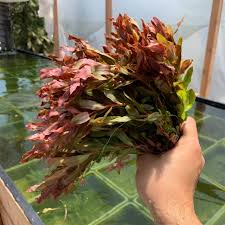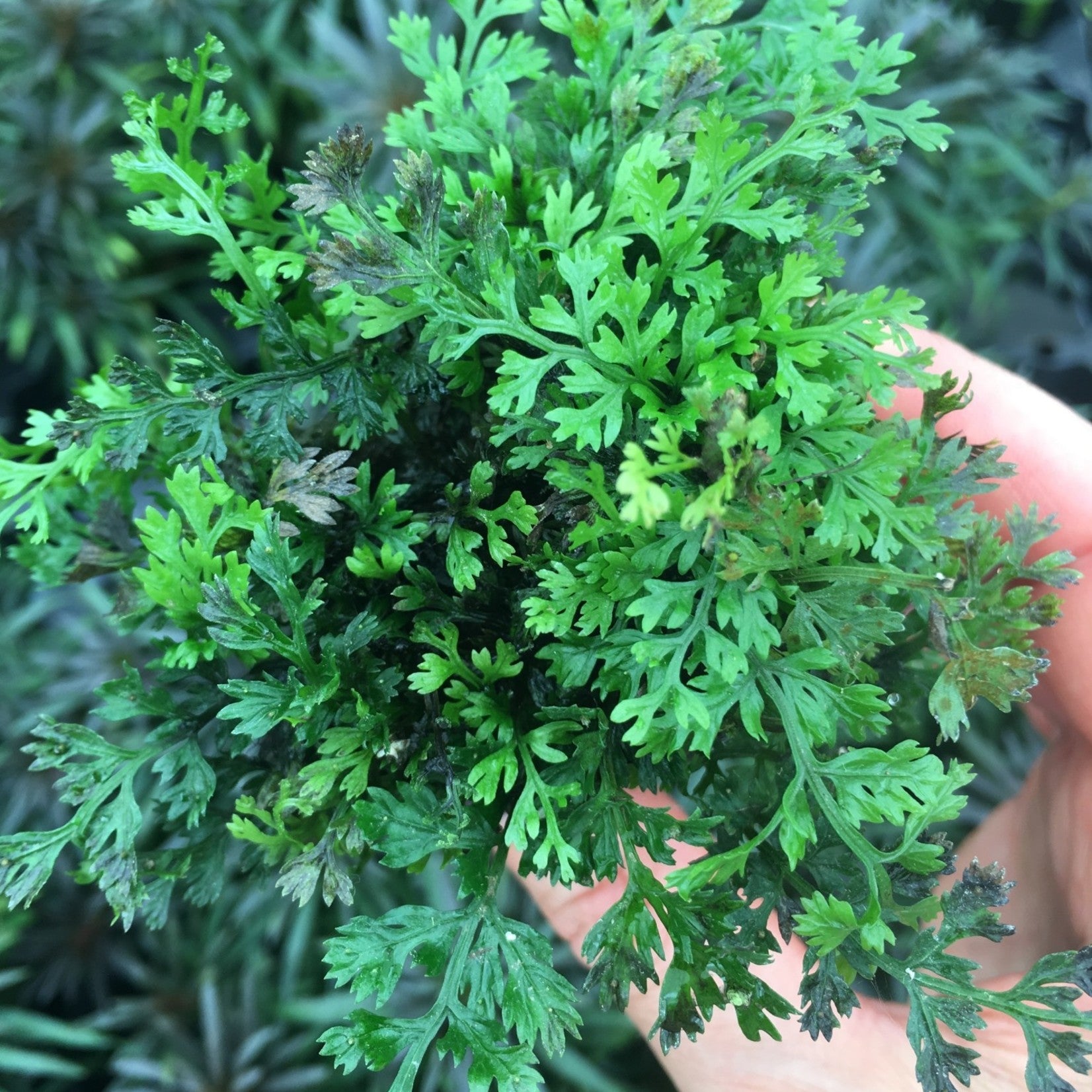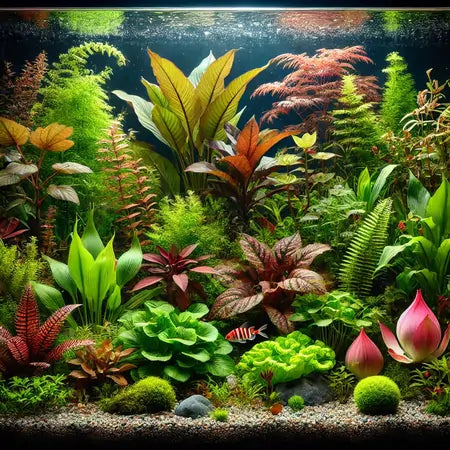Trending searches
$0

Managing the water quality is key to the success of your aquarium and live plants are often the best way to do that. Maintaining the filter and changing the water on a regular basis are both important, but the addition of some aquatic plants can help regulate the water quality and create a healthier environment for your fish.

Aquatic plants play a very important role in the carbon cycle and you can use this to your benefit by designing a plant-filled aquarium, but it’s important to remember that plants should not be used as an alternative to a filtration system, they are an extra source of natural filtration.
Many aquarium owners steer away from using plants in their aquarium because they don’t know what the benefits are, how to use them properly, and how to avoid upsetting the delicate ecosystem they are trying to create in their aquarium. This article will tell you everything you need to know about improving water quality with live aquarium plants.
Before we look at how you can use live aquarium plants, we should look at the reasons why you would want to do it in the first place.
Trying to stay on top of algae growth in your aquarium can be difficult and it’s so frustrating when persistent algae keep returning. Before you know it, algae can completely ruin the amazing tank that you worked so hard to build. However, aquatic plants can be used to combat algae by starving them of key nutrients.
Algae needs iron, nitrates, and potassium to feed on so it is able to photosynthesize. Aquatic plants feed on the same things, so they compete with the algae and starve it of those vital nutrients. Eventually, over time the algae will start to die out. However, this is a constant battle between the algae and aquatic plants and it is important to avoid the balance tipping in favor of the algae. If you use slow-growing aquatic plants, they will not absorb as many nutrients and the algae will be able to compete. But when you introduce fast-growing plants to the environment, they absorb all of the nutrients before the algae have a chance and it will start to die off. You still need to scrape off large clumps of algae when they form but once you find a good balance, your aquatic plants should regulate things for you.
Managing the levels of oxygen in the water is important if you want your fish to be healthy. The fish breathe in oxygen and release carbon dioxide, which needs to be cycled out and replaced with more oxygen. Airstones and pumps can perform this job but they will only agitate the water at the surface level, forcing more oxygen into the tank. Aquatic plants, just like plants on land, draw in the carbon dioxide that is respired by the fish and convert it into oxygen during photosynthesis. This will chemically oxygenate the water and improve the environment for the fish.
If the fish are lacking oxygen, you will notice that they swim to the top of the tank and gulp air in, and their gills. Long periods of rest can also indicate a lack of oxygen. If you start to notice any of these signs, you should add some aquatic plants to oxygenate the water more effectively.
High ammonia levels is one of the most serious water quality issues that fish owners face. Ammonia builds up naturally in the tank and comes from sources such as fish waste and old pieces of fish food. Low levels of Ammonia in the tank will not cause problems but as it starts to build up, it has serious consequences for your fish.
High concentrations of Ammonia can actually burn your fish and they also stop them from taking oxygen into their gills, so it may suffocate them. Many types of algae also feed on Ammonia, so a big increase in algae in the tank is often one of the first signs of high Ammonia levels.
Ammonia also upsets the pH in your aquarium, which has a lot of knock-on effects. pH is a measure of hydrogen ions in the water and it gives an indication of how acidic the water is. Balancing pH is vital in all aquariums because fluctuating pH levels can upset the health of your fish and damage their immune systems. Ideally, aquariums should maintain a pH of 7, which is neutral.
Aquarium plants are very good at absorbing nitrates. Ammonia is a nitrogen compound, so it is absorbed and broken down easily by aquatic plants. Bacteria in the tank are constantly breaking the ammonia down into nitrates and aquatic plants can absorb them at any stage of the nitrogen cycle.
If you rely on pumps and filters alone, you are missing an opportunity to improve the water quality in your aquarium and create a healthier environment for your fish. However, the care needs of aquatic plants can be as complex as the fish themselves and if you do not create the right environment for them, you will not benefit from them.
Growing aquatic plants can be very complex, so it’s important to do your research before you start. There are a few key things that all aquatic plants need to survive:
All plants have different requirements but the majority of them do best with a pH of between 6.5 and 7.8. The nitrate levels should be below 10ppm for plants to thrive. You can test the nitrate levels using a home kit and if levels are too high, you need to find ways to lower them. If you notice algae growing on the leaves of your plants or elsewhere around the tank, that is a sign that nitrate levels are too high.
You should change 10% of the water every week and use a good quality filter to remove pollutants that can affect plant growth. Improving circulation will also encourage healthy plant growth and stop debris from building up on the leaves.
Providing adequate light for your plants is essential if you want them to stay healthy. This can be a challenge because light does not penetrate water very well. In large aquariums, managing the light is especially difficult. Some species will survive with natural light, as long as your aquarium is in the right location. However, certain species are more demanding and will require artificial light.
Aquatic plants need full spectrum lighting with a color range between 6,500K and 8,000K. The color temperature of lights designed for growing houseplants is not suitable for aquatic plants, so make sure that you buy lights specifically designed for aquariums.
Aquatic plants need a consistent light cycle and most varieties do best with 10 to 12 hours of light per day. Do not make the mistake of thinking that leaving the light on for longer will improve the health of your plants.
Using the right substrate in your aquarium is important when using aquatic plants because they need the right environment in which to grow roots. Fine to medium gravel is the best for the majority of different aquatic plant species. Fine sand is too compacted and doesn’t allow the roots to breathe enough. Coarse gravel prevents proper rooting and it is prone to collecting a lot of debris, which can damage the roots.
You should always avoid any calcium-based substrates, like crushed shells or dolomite because they can alter the pH of the water and cause damage to the plants and the fish. Before putting any substrate in your aquarium, always rinse it off thoroughly so you don’t introduce any undesirable material.
When you are putting the substrate in and preparing it for the plants, you should create a slope two or three inches high, rising towards the back of the tank. This slope will help the plants to thrive and create more depth in the tank, which makes it more visually interesting too.
Aquatic plants need a number of nutrients to survive, including nitrogen, phosphorus, potassium, iron, manganese, and magnesium. The nitrogen and phosphorus come from the natural cycle of the tank as it is present in fish waste products and food. However, the rest of the nutrients should be added manually. You can buy liquid aquatic plant food to provide everything they need.
People often wonder whether they should add more CO2 to the tank or not. The short answer is, no you don’t need to add more CO2 because the fish give out enough. Your plants may change in appearance if you add more CO2, but you risk upsetting the balance of the tank and causing damage to the fish.
A lot of people start adding aquatic plants to their tank because they look great, but they have far more benefits than that. When cared for correctly, they can help to improve the water quality and create a healthier environment for your fish, so you should consider adding some to your aquarium today.



Check out our shop for a variety of fresh, farm-grown plants! Find the perfect options to enhance your aquarium today.
!